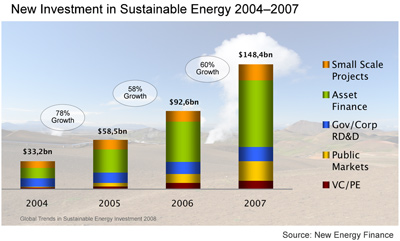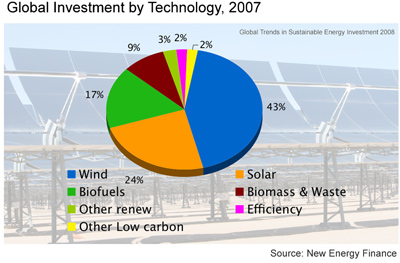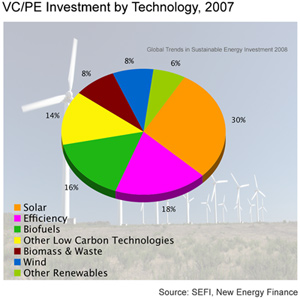With the housing market in the dumps, and Wall Street unsure of what to do next, it is refreshing to see that some people out there still get it. Clean energy investments have been charging forward despite financial market turmoil.

Climate change worries, growing support from world governments, rising oil prices and ongoing energy security concerns have combined to fuel another record-setting year of investment in the renewable energy and energy efficiency industries in 2007, according to an analysis issued Tuesday July 1 by the UN Environment Programme (UNEP).
“The clean energy industry is maturing and its backers remain bullish. These findings should empower governments – both North and South – to reach a deep and meaningful new agreement by the crucial climate convention meeting in Copenhagen in late 2009,†Achim Steiner, the head of UNEP, says.
Says Mohamed El-Ashry, Chair of the Renewable Energy Global Policy Network REN21: “One reason for the steady growth of renewables is simple economics: while the cost of fossil fuel energy is rising, the costs of renewable energy technology are falling. And with renewables there are no fuel costs – and no carbon emissions.â€
“What is unfolding is nothing less than a fundamental transformation of the world’s energy infrastructure.†Mr Steiner UN Under-Secretary General.
Over $148 billion in new funding entered the sustainable energy sector globally last year, up 60% from 2006, even as a credit crunch began to roil financial markets, according to the report, “Global Trends in Sustainable Energy Investment 2008,†(download here 2.8m pdf)prepared by UK-based New Energy Finance for UNEP’s Paris-based Sustainable Energy Finance Initiative.
Wind energy again attracted the most investment ($50.2 billion in 2007), but solar power grew most rapidly: attracting some $28.6 billion of new capital and growing at an average annual rate of 254% since 2004, driven by the advent of larger project financings.
The picture since the end of 2007 has been somewhat subdued across the sector, with only mergers and acquisitions up as several substantial wind developers sold their portfolios – many realizing that with the tightening up of the credit markets they could not finance the growth themselves – and the US ethanol industry undergoing restructuring…a nice way of saying people are realizing ethanol is a crappy way to subsidize big agra-business and little else. But in the second quarter of 2008 most areas of investment rebounded, even as global financial markets remained in turmoil. Sustainable energy venture capital and private equity in Q2 2008 was up 34% on Q2 2007, new build asset finance was up 8% and public market investment showing a strong recovery with the IPO of Portuguese utility EDP’s renewable energy business, EDP Renovaveis.
“Just as thousands were drawn to California and the Klondike in the late 1800s, the green energy gold rush is attracting legions of modern day prospectors in all parts of the globe,†says Mr Steiner, who is also a UN Under-Secretary General. “A century later, the key difference is that a higher proportion of those looking for riches today may find them. With world temperatures and fossil fuel prices climbing higher, it is increasingly obvious to the public and investors alike that the transition to a low-carbon society is both a global imperative and an inevitability. This is attracting an enormous inflow of capital, talent and technology. But it is only inevitable if creative market mechanisms and public policy continue to evolve to liberate rather than frustrate this clean energy dawn.

Most of the new money flowed into Europe (who are far ahead in promoting renewable energy), followed by the USA. However, China, India and Brazil draw growing investor interest, their share of new investment growing from 12% in 2004 to 22% in 2007, an increase in absolute terms of 14 times, from $1.8 billion to $26 billion. It is good to see the so called “developing world” investing heavily in renewable energy. In fact is probably the only way they could ever hope to meet their growing energy needs without destroying the global environment and themselves in the process.
Total 2007 sustainable energy transaction volume was $204.9 billion, of which $98.2 billion went into new renewable energy generation (especially wind in the US, China and Spain), $50.1 billion went into technology development and manufacturing scale-up, and $56.6 billion changed hands through mergers and acquisitions.
With 31 gigawatts of new installed generation, sustainable energy accounted for 23% of new power capacity added globally in 2007, about 10 times that of nuclear. Sustainable energy companies accounted for 19% of all new capital raised by the energy sector on the global stock markets in 2007.
“Investment in the sustainable energy sectors must continue to grow strongly if targets for greenhouse gas reductions and renewables and efficiency increases are to be met,†says the report.
“Investment between now and 2030 is expected to reach $450 billion a year by 2012, rising to more than $600 billion a year from 2020. The sector’s overall performance during 2007 and into 2008 sets it on track to achieve these levels.†Says Michael Liebreich, CEO of New Energy Finance Ltd, a co-author of the report: “2007 was a banner year for the clean energy industry. Wind continued its strong progress, with installed capacity passing the 100 GW mark. Solar is maturing rapidly, with heavy investment to ease the silicon bottleneck and new thin-film technology beginning to reach scale. And there are plenty of other technologies lining up to be the next ones to begin a real march to scale – including biomass and geothermal. Carbon Capture and Storage (CCS) is the only sector where we did not see as much progress as we had expected, with the regulatory and funding environments for these projects remaining murky and timelines for the first commercial projects being extended.â€
According to Yvo de Boer, Executive Secretary of the United Nations Framework Convention on Climate Change: “The positive trend in the renewable energy market is at least in part a business response to a policy expectation. If that expectation is not met, the conventional bottom-line will be the main driver for investment decisions. To put it another way, business people think that politicians are going to do a certain thing (promote clean energy) and if they don’t all this positive growth could sputter, and ohh by the way the earth might be destroyed. No biggy.
“According to the IEA, a massive amount of US $20 trillion is projected to be invested to meet the world’s energy demand in 2030. If these investments are not made in a climate-friendly way, emissions of green house gases might go up by 50% in 2050, while science tells us they need to be cut by 50% in 2050. I hear businesses crying out for clear policy signals to make the right investment decisions today. Setting a long term target for 2050 is useful, but I think it would give investors much more clarity if rich countries would indicate where they want to be in 2020 or 2030.” This is a very nice way of saying that America is fucking it up for global business. If we would simply announce that we are moving to a carbon neutral (or even negative) economy, the world would get right in line behind us. Even though we have a “pro-business” president, he seems to pro-carbon business. We can only hope for the sake of our economy, and our planet that the next person in office is a bit more far sighted.

The report offers a host of insights into sustainable energy investment worldwide:
Wind
Wind attracted more investment globally last year than any other non-fossil fuel based technology, including large hydro and nuclear power. In Europe and the US wind capacity additions in 2007 on their own accounted for 40% and 30%, respectively, of new power capacity.
Iberenova, the wind power development arm of Spanish power giant Iberdrola, raised $7.2 billion in a landmark flotation in December 2007, the largest Spanish IPO ever and the fourth largest public deal of the year.
Global installed wind capacity surpassed 100GW in March 2008.
Ethanol
With US feedstock costs up and ethanol prices down, venture capital and private equity investment in biofuels fell by almost one-third in 2007, to $2.1 billion. However, biofuels investment has not dried up altogether, shifting to Brazil, India and China.
Solar
Solar surged ahead in 2007, increasing its share of almost every investment category. Solar attracted by far the most venture capital and private equity investment ($3.7 billion), although biomass and waste to energy saw the fastest (432%) growth.
During 2007 Chinese solar companies raised $2.5 billion on the US and Europe equity capital markets.
Energy efficiency
Investment in energy efficiency technology reached a record $1.8 billion, an increase of 78% from 2006.
North America attracted most energy efficiency investment during 2007, followed by Europe, despite the fact that its energy legislation lags behind Europe.
Buildings offer by far the greatest energy saving potential (and represent the source of 40% of CO2 emissions). Industry and the transport efficiency follow, with the power sector (perhaps surprisingly) as the sector with the least scope for savings.
According to the International Energy Agency, each $1 invested in energy efficiency an average avoids more than $2 needed to create new supply.
Europe still leads
The EU remained the leading region for investment, particularly later-stage financing. Supportive policies, as well as an investor base that is comfortable with financing renewable energy projects and more intense competition for deals, drove European asset finance to a record level of $49.5 billion in 2007. This was 62% of asset finance worldwide.
Strong growth in USA
In the USA acceptance of sustainable energy became more widespread, extending beyond its traditional heartland of California, with Texas leading the wind energy charge. A new administration in 2009 is expected to make renewable energy and energy efficiency a political priority while recent uncertainty in the US (particularly over the possible introduction of a CO2 regulations) has put a significant number of coal-fired generation plants on hold.
The US financial sector is also gearing up for a major shift in political attitude. Citi, JPMorgan Chase and Morgan Stanley have jointly launched a set of “Carbon Principles”, which will guide how they lend to and advise major power companies in the US.
The banks developed the principles to evaluate risks in financing carbon-emitting projects, given the growing uncertainty around regional and national climate change policy. They will also consider power companies’ inclusion of energy efficiency and renewable resources in their portfolios as part of an “enhanced diligence processâ€.
China
During 2007, investment in non-hydro renewables capacity in China increased by more than four times, to $10.8 billion, and new wind capacity doubled to 6 gigawatts.
The report says the 2008 Beijing Olympic Games “sharpened the country’s political resolve and strengthened programmes to promote cleaner generation and cut energy intensity..â€
Besides a surge of Chinese solar companies listing on US and European stock markets, public market activity is also growing at home. Notably, the Chinese wind manufacturer Goldwind raised $243 million last year in the Shenzhen Stock Exchange’s first IPO related solely to renewable energy.
Brazil
Brazil is the world’s largest renewable energy market, thanks to its long established hydropower and bioethanol industries.
Sustainable energy investment in Brazil continued to be dominated by ethanol in 2007, as investor interest shifted there from the beleaguered US ethanol market. Infinity Bio-Energy (listed on London AIM) and the US agribusiness giant Cargill both made important investments in the sector.
Beyond ethanol production, investment in sugar cane cogeneration, biodiesel production and wind generation are also picking up.
India
Asset financing in India grew significantly, to $2.5 billion, mostly for 1.7GW of new wind projects. These installations place India fourth in the world, both in terms of new capacity added in 2007 and total installed capacity.
Funds raised on Indian stock exchanges reached $628 million in 2007, although companies increasingly looked to foreign markets for new capital, raising $1.4 billion overseas in 2007. Public market activity was marked by a series of Foreign Currency Convertible Bonds (FCCBs) from established Indian renewable energy companies such as Suzlon ($500 million raised) and Moser Baer ($150 million).
The year 2007 also saw several aggressive cross-border deals involving Indian or Chinese acquirors, including Suzlon’s $1.6 billion acquisition of Repower and China National Building Material Group’s purchase of German turbine blade manufacturer NOI Rotortechnik.
Africa
Africa continues to lag other regions in terms of sustainable energy investment. Asset finance, however, was up in 2007 to $1.3 billion (five times as much as in 2006), reversing a gradual decline since 2004 and bearing witness to increasing installed renewable capacity. Investment was mainly in biofuels and geothermal. Promising large-scale solar developments were also initiated in North Africa and some signs of change in South Africa, where targets for renewable energy have been set and the country’s first wind farm commissioned.
Sub-Saharan Africa, “arguably the region that has the most to gain from renewable energy,†remains largely unexploited, according to the report.
Carbon finance shifting to the private sector
$13 billion had been invested in carbon funds by the end of 2007, an important source of investment for “Clean Development Mechanism†projects in developing countries. Most new investment was into private funds as carbon trading becomes more established.
The first quarter of 2008 saw the emergence of private interest in the post-Kyoto market, with investors beginning procuring post-2012 CDM credits eligible for trading in the EU Emissions Trading Scheme.
Market broadens, diversifies into emerging technologies
Investments not only grew in 2007, but broadened and diversified. Mainstream capital markets are now fully receptive to sustainable energy companies, according to the report.
2007 also saw greater activity in so-called “next generation technologies,†such as cellulosic ethanol, thin-film solar technologies and energy efficiency.
Early venture capital investment surged 112% to $2 billion in 2007, boosted by interest in emerging renewable technologies, rather than just those on the brink of commercialisation.
“The willingness to look beyond mature technologies suggests that investors are taking renewable energy and energy efficiency increasingly seriously,†the report says.
Public investment
General public investments, through stock and other markets, more than doubled in 2007 to $23.4 billion, up from $10.5 billion in 2006.
The Wilderhill New Energy Global Innovation Index (NEX) rose 57.9% in 2007. It then fell 17.9% in first quarter of 2008 but recovered half this loss in the second quarter.
Meanwhile, assets under management in clean energy funds rose to $35 billion in 2007.
A record 17 new clean energy public equity fund launches occurred in 2007, up from just five in 2006. Several of these were ‘climate change’ funds launched by mainstream investment firms including HSBC, F&C, Schroders, Deutsche Asset Management and Virgin Money.
The arrival of such heavyweights in the market is “likely to encourage the larger publicly listed companies they normally invest in to expand into sustainable energy and other low carbon sectors,†says the report.
Research & Development
Research & Development spending on clean energy and energy efficiency was $16.9 billion in 2007, including corporate R&D of $9.8 billion, and government R&D of $7.1 billion.
Europe and the Middle East saw the most corporate R&D activity, followed by the Americas and then Asia. Patterns of government R&D are the reverse, with Asian governments (notably Japan, China and India) investing relatively heavily in R&D.
Corporate Mergers & Acquisition
Corporate Mergers & Acquisition activity increased 52% to $25.7 billion in 2007.
One thought on “Investment In Clean Energy Up 60%, Tops 148 Billion Dollars in 2007”
Comments are closed.